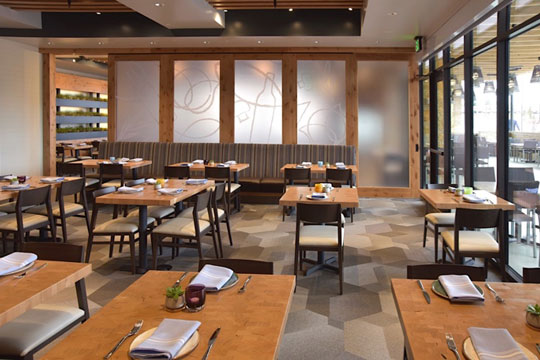Asian Fusion Restaurant: An Unique Dining Experience in the Heart of Islamabad
Asian Fusion Restaurant: An Unique Dining Experience in the Heart of Islamabad
Blog Article
Savor Genuine Oriental Cuisine With a Pan-Asian Spin for a Culinary Experience
Beginning on a culinary journey through genuine Eastern cuisine, boosted with a Pan-Asian spin, supplies an one-of-a-kind possibility to explore the abundant tapestry of flavors that specify the area's varied culinary practices. This experience welcomes you to appreciate the exquisite equilibrium of preferences-- sweet, salted, spicy, and sour-- integrated by fragrant herbs and spices. Think of the ingenious combination of Thai curry and ramen or the unexpected joy of sushi burritos. As you contemplate these tempting recipes, think about the social narratives and historical influences that shape them, each bite using a story waiting to be found.

Exploring Pan-Asian Flavors
In the realm of worldwide gastronomy, Pan-Asian cuisine stands apart for its impressive variety and the harmonious interplay of flavors from different Eastern societies. This cooking approach celebrates the one-of-a-kind active ingredients and abundant customs located across the continent, producing a tapestry of tastes that is both enjoyable and appealing. Key to Pan-Asian cuisine is its capacity to balance contrasting flavors-- wonderful, salty, spicy, and sour-- while highlighting the freshness and quality of each active ingredient.
From the umami-rich soy sauce of Japan to the intense chili peppers of Thailand, Pan-Asian food offers a substantial palette of flavors. These elements are usually integrated in innovative methods, enhancing recipes with layers of complexity. As an example, the use of fragrant herbs such as lemongrass and cilantro, typical in Vietnamese and Thai food, adds a refreshing illumination to dishes, while the unification of coconut milk delivers a luscious, abundant texture.
The emphasis on fresh fruit and vegetables and aromatic spices makes sure that each meal is not just a feast for the taste yet likewise for the senses. Pan-Asian food welcomes restaurants to embark on a culinary trip, checking out the huge and differed landscapes of Asian gastronomy with every bite.
Blend Meals to Try
While Pan-Asian food is commemorated for its traditional tastes, the contemporary cooking landscape is increasingly accepting fusion meals that mix these traditional elements with impacts from other regions. This ingenious technique not only honors the rich heritage of Asian cookeries yet likewise introduces novel taste experiences that appeal to contemporary tastes.
An archetype of such a fusion dish is the Korean-Mexican taco, where seasoned bulgogi beef is wrapped in a warm tortilla, topped with kimchi and a spicy gochujang-infused salsa. This mix weds the strong, savory flavors of Korea with the vivid, fresh aspects of Mexican food. Similarly, sushi burritos have gained popularity, joining together the delicate creativity of Japanese sushi with the passionate, hand-held benefit of a burrito, usually including fusion active ingredients like tempura shrimp and avocado with a drizzle of wasabi mayo.
An additional significant recipe is Thai curry ramen, which instills the creamy, aromatic flavors of Thai curry into the reassuring brew of conventional Japanese ramen, creating a harmonious blend that tantalizes the senses. These blend meals prolong past plain uniqueness; they stand for a culinary dialogue between cultures, motivating expedition and advancement on the planet of Pan-Asian cuisine.
Vital Ingredients and Flavors
To genuinely value Pan-Asian cuisine, one have to comprehend the important ingredients and spices that form its structure. This varied culinary design attracts from a rich tapestry of Asian customs, utilizing a harmonious blend of tastes and appearances.
Fragrant aspects are critical, with ginger, lemongrass, and garlic being ubiquitous throughout different Pan-Asian dishes. These active ingredients provide an aromatic base that boosts the intricacy of tastes. Seasonings such as star anise, cardamom, and cinnamon present warmth and character, echoing influences from areas like China and India.

Food Preparation Methods and Tips
Understanding the art of Pan-Asian food needs experience with its distinctive food preparation strategies, each adding to the vibrant tapestry of flavors this culinary tradition is celebrated for. Central to these approaches is the stir-fry, a rapid food preparation technique that preserves the dietary integrity and vibrant shades of components. Making use of a wok, the stir-fry approach permits for even warm distribution, important for accomplishing the particular structure and taste balance of Pan-Asian meals.
One more fundamental method is steaming, especially common in Chinese cuisine. This mild technique preserves the all-natural tastes and nutrients of active ingredients, making it excellent for seafood and vegetables. Dumplings, a beloved staple, commonly take advantage of steaming, leading to soft, succulent appearances.
Grilling, also important, presents great smoky midsts to recipes such as Oriental bulgogi or Japanese yakitori (Fine dining experience Islamabad). This strategy commonly involves marinating components, allowing flavors to permeate deeply prior to food preparation over an open fire or warmer
Lastly, understanding the art more information of stabilizing flavors-- wonderful, sour, salted, bitter, and umami-- is crucial. Effectively layering these components can boost a recipe from ordinary to extraordinary, supplying a facility and pleasing culinary experience that embodies the essence of Pan-Asian food.
Dining Experiences Worldwide
Around the world, Pan-Asian cuisine uses an unmatched eating experience, celebrated for its abundant tapestry of flavors and dynamic discussions. This culinary phenomenon has transcended cultural borders, capturing the hearts and palates of food lovers worldwide. In cosmopolitan cities like New York, London, and Sydney, Pan-Asian dining establishments act as melting pots where cooking practices from Thailand, Japan, China, and beyond assemble, providing restaurants with a diverse mix of recipes that highlight the area's variety.
The worldwide charm of Pan-Asian food hinges on its capability to use both authenticity and development. Chefs skillfully marry typical active ingredients such as lemongrass, soy sauce, and miso with modern techniques, causing recipes that are both acquainted and refreshingly new. This combination enables restaurants to start a culinary trip that appreciates heritage while embracing modernity.
Furthermore, eating experiences are raised with thoughtfully designed settings that mirror the principles of Pan-Asian visual appeals. From minimal Japanese-inspired interiors to lively Thai-themed areas, each restaurant supplies an unique ambiance that enhances the culinary offerings. Therefore, clients are not simply consuming a dish but partaking in a social experience, making Pan-Asian eating a really worldwide phenomenon.
Verdict
The exploration of Pan-Asian food offers a profound understanding of the intricate interaction of tastes and cooking customs throughout Asia. By welcoming fusion dishes such as Thai curry ramen and sushi burritos, the cooking journey not just highlights the versatility of conventional ingredients however also showcases cutting-edge contemporary methods. This gastronomic adventure, improved by vital spices and cooking methods, offers an one-of-a-kind opportunity to appreciate the social variety and cooking creativity click to find out more that specify Pan-Asian cuisine on an international scale.
Getting started on a culinary journey through authentic Oriental cuisine, enhanced with a Pan-Asian twist, uses an one-of-a-kind opportunity to explore the rich tapestry of tastes that specify the area's diverse cooking customs.In the world of global gastronomy, Pan-Asian food stands out for its amazing diversity and the harmonious interplay of flavors from different Asian cultures. Secret to Pan-Asian cuisine is its capability to balance different tastes-- sweet, salted, spicy, and sour-- while highlighting the freshness and top article quality of each component.

Report this page